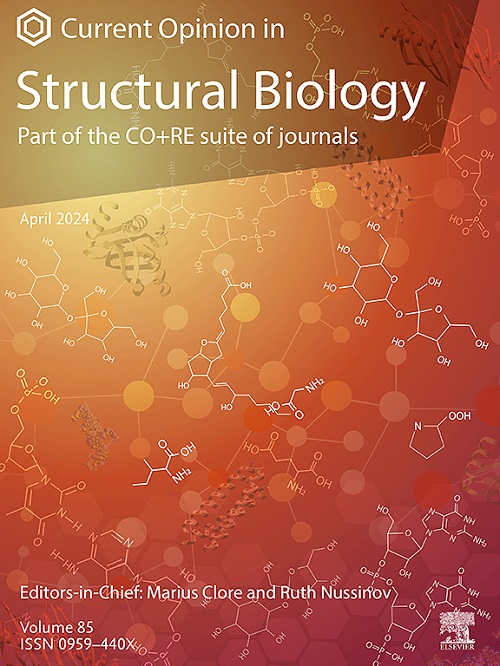RNA模拟的最小模型
IF 6.1
2区 生物学
Q1 BIOCHEMISTRY & MOLECULAR BIOLOGY
引用次数: 0
摘要
RNA在生物学中扮演的主要角色越来越重要,这一点怎么强调都不为过。RNA中的问题,如折叠和驱动相分离的RNA - RNA相互作用,需要阳离子。由于实验本身无法揭示阳离子-RNA相互作用的动力学,因此需要精心校准的理论和计算来预测离子如何控制RNA的行为。透视图描述了不同分辨率下粗粒度模型的开发和使用。我们专注于单和三相互作用的站点模型,其中静电相互作用使用显式和隐式表示的组合来处理。讨论了在核酶和核开关折叠中的应用,重点讨论了单价和二价阳离子的作用。我们还讨论了低复杂度序列的相分离。在模拟复杂的问题,如核糖体组装和RNA伴侣,需要发展的RNA-蛋白质相互作用的模型的挑战,指出。本文章由计算机程序翻译,如有差异,请以英文原文为准。
Minimal models for RNA simulations
The increasing importance of RNA as a prime player in biology can hardly be overstated. Problems in RNA, such as folding and RNA–RNA interactions that drive phase separation, require cations. Because experiments alone cannot reveal the dynamics of cation-RNA interactions, well calibrated theory and computations are needed to predict how ions control the behavior of RNA. The perspective describes the development and use of coarse-grained models at different resolutions. We focus on single- and three-interaction site models, in which electrostatic interactions are treated using a combination of explicit and implicit representations. Applications to the folding of ribozymes and riboswitches are discussed, with emphasis on the role of monovalent and divalent cations. We also discuss phase separation in low-complexity sequences. Challenges in the simulation of complex problems such as ribosome assembly and RNA chaperones, requiring developments of models for RNA-protein interactions, are pointed out.
求助全文
通过发布文献求助,成功后即可免费获取论文全文。
去求助
来源期刊

Current opinion in structural biology
生物-生化与分子生物学
CiteScore
12.20
自引率
2.90%
发文量
179
审稿时长
6-12 weeks
期刊介绍:
Current Opinion in Structural Biology (COSB) aims to stimulate scientifically grounded, interdisciplinary, multi-scale debate and exchange of ideas. It contains polished, concise and timely reviews and opinions, with particular emphasis on those articles published in the past two years. In addition to describing recent trends, the authors are encouraged to give their subjective opinion of the topics discussed.
In COSB, we help the reader by providing in a systematic manner:
1. The views of experts on current advances in their field in a clear and readable form.
2. Evaluations of the most interesting papers, annotated by experts, from the great wealth of original publications.
[...]
The subject of Structural Biology is divided into twelve themed sections, each of which is reviewed once a year. Each issue contains two sections, and the amount of space devoted to each section is related to its importance.
-Folding and Binding-
Nucleic acids and their protein complexes-
Macromolecular Machines-
Theory and Simulation-
Sequences and Topology-
New constructs and expression of proteins-
Membranes-
Engineering and Design-
Carbohydrate-protein interactions and glycosylation-
Biophysical and molecular biological methods-
Multi-protein assemblies in signalling-
Catalysis and Regulation
 求助内容:
求助内容: 应助结果提醒方式:
应助结果提醒方式:


